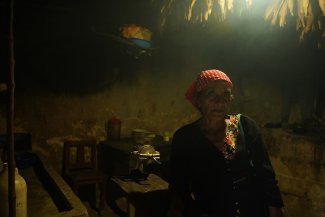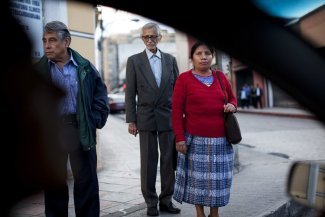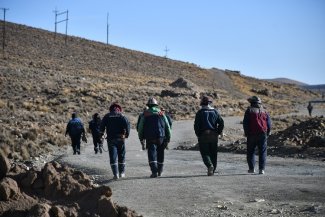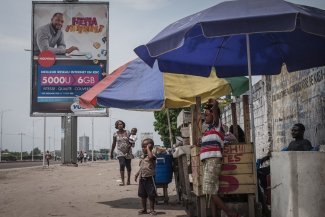
While the journey that migrants take to cross the US border can be perilous, those who are deported face another series of trials upon their return home, including stigma, shame, and difficulty reintegrating into families and finding work. In this image from 2021, Central American migrants wait to board the train known as La Bestia (The Beast).
Central Americans of the Northern Triangle (El Salvador, Guatemala and Honduras) who make the desperate decision to cross into the United States illegally face significant hardships throughout their journey. Leaving Guatemala entails paying a driver or human smuggler (a pollero, or ‘poulterer’ in Mexico, a coyote in Guatemala), which can cost up to US$10,000. This is followed by a high-risk journey through Mexico on the freight train known as La Bestia (‘The Beast’) or the Tren de la Muerte (‘The Death Train’), or the increasingly common and even more dangerous option of travelling by road in overcrowded lorry cargo-holds. Migrants cross harsh environments, such as the Rio Grande River and the deserts of the southern United States. Throughout their journey, they face robbery, assault and extortion by both criminals and authorities, as well as sexual assault.
Thousands of Guatemalans face these dangers every year in search of a better life. The US Migration Policy Institute (MPI) estimates that there were 1.3 million Guatemalan migrants residing in the United States in 2020, more than half of them illegally. This lack of legal status often leads migrants to submit to highly precarious working conditions and leaves them in a permanent state of fear of arrest, deportation and loss of accumulated wealth.
Unlike migrants from other countries who come to the United States fleeing violence, migrants from Guatemala are primarily driven by economic factors. The monthly minimum wage for non-agricultural work in Guatemala is equivalent to US$353, while the cost essential food stuffs alone is estimated at US$375. Only 17 per cent of private employees in the country earn above this amount, while only 35 per cent of wage earners are covered by social security - just 18 per cent of the country’s total employed population.
This situation is exacerbated by the virtual absence of trade unions and collective bargaining in private companies
Countries with higher levels of social development are able to guarantee access to education and health care. Guatemalans have difficulty accessing both.
Only one in four adolescents (aged 15-18) has access to secondary education and 82 per cent of those who are enrolled study in private schools. Meanwhile, 26 per cent of young people aged 15 to 29 neither study nor work. When it comes to healthcare, the picture is similarly bleak: public health spending is the third lowest in Latin America (barely 2 per cent of GDP). In practice, 62 per cent of the country’s total health spending comes directly out of the pockets of its citizens. To further complicate matters, remittances from abroad, which play a major role in reducing or alleviating poverty in other Latin American and Caribbean countries, only reached around 126,000 families in Guatemala in 2021.
The difference between the income that Guatemalans can earn in Guatemala versus what they can earn in the United States is abysmal. According to the testimony of a Guatemalan resident of Chicago reported by the daily Prensa Libre: “In Guatemala you live to work; in the United States you work to live”.
The figures speak for themselves: in 2018, farm labourers in the US earned around US$12 per hour. By working eight hours a day for 25 days, they could thus earn US$2,400 a month. Another report from 2022 indicates that hotel maids could earn US$15.25 per hour. Both salaries are unthinkable in the Central American country.
Guatemalans who do succeed in reaching the United States and finding work there find themselves at a disadvantage with respect to their Latino peers, earning less on average (US$23,000 per year) than other Hispanics.
This is evidenced by their investments: only 32 per cent of Guatemalans in the US have purchased homes, compared to 47 per cent of other Hispanics. In addition, only 48 per cent of Guatemalans in the United States are fluent in English. By contrast, 87 per cent of Panamanians speak English, which undoubtedly facilitates their integration into the country.
Despite these disadvantages, remittances from the United States remain the cornerstone of the Guatemalan economy. In 2021, they amounted to US$11 billion, almost as much as total national exports in the same year (US$13.6 billion). Individual remittance payments amount to an average of US$490, which represents a major source of support for families. Converted into quetzales, this amount alone is already 15 per cent higher than Guatemala’s current minimum wage.
The trauma of deportation
Not all Guatemalan migrants to the United States meet with success. Against the backdrop of the global financial crisis, 2010 saw a sharp increase in the number of returning migrants, both by land (those who do not make it to the US and are deported from Mexico) and by air (those expelled from the US). Since 2010, 488,550 Guatemalan citizens have been deported from Mexico and another 453,961 from the United States, for a total of almost one million people as of July this year.
For those who have already risked the perilous journey to cross the US border, deportation entails an additional series of traumatic events. As I outlined in a recent study on the impact of deportation, migrants face shame, stigma, family separation, economic damage and, upon returning home, difficulty reintegrating into family and work life.
Return migrants are, in reality, a heterogeneous group. Those returning from Mexico face similar or worse conditions than people residing in Guatemala in terms of education and work experience. Migrants in Mexico find themselves subject to precarious labour conditions and without a social safety net.
The situation is somewhat different for deportees from the US who, according to the amount of time they spent their and the field in which they worked, have advantages in terms of professional skills, high productivity, handling of advanced tools and machines, command of English and work discipline. But even these returnees face a limited supply of jobs, discriminatory barriers for reasons as arbitrary as having tattoos, residing in areas inappropriately labelled ‘red’ by security specialists, having no references from previous employers, or simply the prejudice that they will leave their job to try to migrate back to the US.
Unfinished business
What kind of support do return migrants require? For starters, as one Guatemalan returnee put it, a dignified welcome; transforming the official discourse on the heroism of migrants and the contribution of their remittances to the economy into actual deeds. Guatemala’s current president once bragged that Guatemalans sent over a billion in remittances a month, as if he were in any way responsible for that figure. Both the testimonies I collected for my study of social and labour reintegration of migrants and the reports of the Human Rights Ombudsman reveal that the government offers little in the way of dignified and comprehensive reception.
Moreover, Guatemalan diplomats who visit Guatemalan migrants awaiting deportation in US detention centres promise that the government will organise transportation for the migrants upon their return. In reality, however, this service is limited to transporting returnees to the departure points of the transport service, sometimes even late at night.
A ‘dignified welcome’ should also include psychosocial care, a service which most returning migrants need and which should be provided by the public health system.
Migrants returning from the United States would also greatly benefit from skill certification, which should be a free public service, while those returning from Mexico require vocational training. Both would benefit from training in soft skills as well as a labour intermediation service (an essential component of active employment policies in any country), allowing returnees to make contact with potential employers through the National Employment Service of the Ministry of Labour, which should also carry out studies on supply and demand in the national labour market.
Few, if any, of these needs are satisfactorily met by the state
Support for return migrants comes almost exclusively from international cooperation projects and non-governmental organisations, as is the case in El Salvador. These entities address almost all of the needs laid out in the previous paragraph but are limited in their reach and resources. The government, which should assume these responsibilities, is currently failing to do so.
The Consejo Nacional de Atención al Migrante Guatemalteco (National Council for Assistance to Guatemalan Migrants, CONAMIGUA), established in 2008 to coordinate assistance to migrants, has so far performed poorly, while the Instituto Guatemalteco de Migración (Guatemalan Migration Institute), created in 2016 and in operation since 2019, does not comply with the migration policy set out in the constitutional law that created it, which should be the first step to addressing the problems that migrants face. Finally, the Ministry of Foreign Affairs is responsible for consular protection, which is also deeply flawed. A Guatemalan resident of Atlanta (USA) told me that the consulate in that city only assists citizens by appointment over the telephone. He spent almost all of 2021 trying to call them to no avail.
Compounding this neglect of its own citizens, the Ministry of Labour does not provide efficient labour intermediation services nor does it address the employment training needs faced by returnees from Mexico or the labour force in general. In short, although tasks have been defined, there is still a long way to go.
As Catholic missionary Mauro Verzeletti, who for many years was the director of and most eloquent advocate for the Casa del Migrante in Guatemala, said a few months ago, while the official policy continues to be “go away, we need the remittances,” the reality is that successive governments, mired in corruption and impunity, continue to fail to meet their responsibilities.












